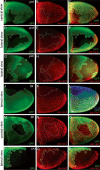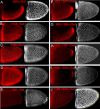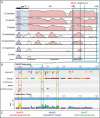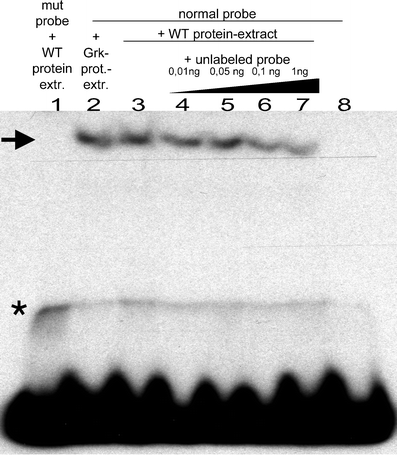Molecular mechanisms of EGF signaling-dependent regulation of pipe, a gene crucial for dorsoventral axis formation in Drosophila
- PMID: 22198544
- PMCID: PMC3291829
- DOI: 10.1007/s00427-011-0384-2
Molecular mechanisms of EGF signaling-dependent regulation of pipe, a gene crucial for dorsoventral axis formation in Drosophila
Abstract
During Drosophila oogenesis the expression of the sulfotransferase Pipe in ventral follicle cells is crucial for dorsoventral axis formation. Pipe modifies proteins that are incorporated in the ventral eggshell and activate Toll signaling which in turn initiates embryonic dorsoventral patterning. Ventral pipe expression is the result of an oocyte-derived EGF signal which down-regulates pipe in dorsal follicle cells. The analysis of mutant follicle cell clones reveals that none of the transcription factors known to act downstream of EGF signaling in Drosophila is required or sufficient for pipe regulation. However, the pipe cis-regulatory region harbors a 31-bp element which is essential for pipe repression, and ovarian extracts contain a protein that binds this element. Thus, EGF signaling does not act by down-regulating an activator of pipe as previously suggested but rather by activating a repressor. Surprisingly, this repressor acts independent of the common co-repressors Groucho or CtBP.
Figures








Similar articles
-
Maternal control of the Drosophila dorsal-ventral body axis.Wiley Interdiscip Rev Dev Biol. 2014 Sep-Oct;3(5):301-30. doi: 10.1002/wdev.138. Epub 2014 May 29. Wiley Interdiscip Rev Dev Biol. 2014. PMID: 25124754 Free PMC article. Review.
-
EGFR-dependent downregulation of Capicua and the establishment of Drosophila dorsoventral polarity.Fly (Austin). 2012 Oct-Dec;6(4):234-9. doi: 10.4161/fly.21160. Epub 2012 Aug 10. Fly (Austin). 2012. PMID: 22878648 Free PMC article.
-
Mirror represses pipe expression in follicle cells to initiate dorsoventral axis formation in Drosophila.Development. 2012 Mar;139(6):1110-4. doi: 10.1242/dev.076562. Epub 2012 Feb 8. Development. 2012. PMID: 22318229
-
Mechanisms of Gurken-dependent pipe regulation and the robustness of dorsoventral patterning in Drosophila.Development. 2002 Jun;129(12):2965-75. doi: 10.1242/dev.129.12.2965. Development. 2002. PMID: 12050143
-
Signaling between somatic follicle cells and the germline patterns the egg and embryo of Drosophila.Curr Top Dev Biol. 2020;140:55-86. doi: 10.1016/bs.ctdb.2019.10.004. Epub 2019 Nov 19. Curr Top Dev Biol. 2020. PMID: 32591083 Review.
Cited by
-
Transcriptional interpretation of the EGF receptor signaling gradient.Proc Natl Acad Sci U S A. 2012 Jan 31;109(5):1572-7. doi: 10.1073/pnas.1115190109. Epub 2012 Jan 17. Proc Natl Acad Sci U S A. 2012. PMID: 22307613 Free PMC article.
-
Maternal control of the Drosophila dorsal-ventral body axis.Wiley Interdiscip Rev Dev Biol. 2014 Sep-Oct;3(5):301-30. doi: 10.1002/wdev.138. Epub 2014 May 29. Wiley Interdiscip Rev Dev Biol. 2014. PMID: 25124754 Free PMC article. Review.
-
EGFR-dependent downregulation of Capicua and the establishment of Drosophila dorsoventral polarity.Fly (Austin). 2012 Oct-Dec;6(4):234-9. doi: 10.4161/fly.21160. Epub 2012 Aug 10. Fly (Austin). 2012. PMID: 22878648 Free PMC article.
-
Co-option of a coordinate system defined by the EGFr and Dpp pathways in the evolution of a morphological novelty.Evodevo. 2013 Mar 1;4(1):7. doi: 10.1186/2041-9139-4-7. Evodevo. 2013. PMID: 23448685 Free PMC article.
-
The Capicua repressor--a general sensor of RTK signaling in development and disease.J Cell Sci. 2012 Mar 15;125(Pt 6):1383-91. doi: 10.1242/jcs.092965. J Cell Sci. 2012. PMID: 22526417 Free PMC article. Review.
References
-
- Atkey MR, Lachance JF, Walczak M, Rebello T, Nilson LA. Capicua regulates follicle cell fate in the Drosophila ovary through repression of mirror. Development. 2006;133:2115–2123. - PubMed
-
- Bailey TL, Elkan C. Fitting a mixture model by expectation maximization to discover motifs in biopolymers. Proc Int Conf Intell Syst Mol Biol. 1994;2:28–36. - PubMed
-
- Bailey TL, Elkan C. The value of prior knowledge in discovering motifs with MEME. Proc Int Conf Intell Syst Mol Biol. 1995;3:21–29. - PubMed
Publication types
MeSH terms
Substances
LinkOut - more resources
Full Text Sources
Molecular Biology Databases

